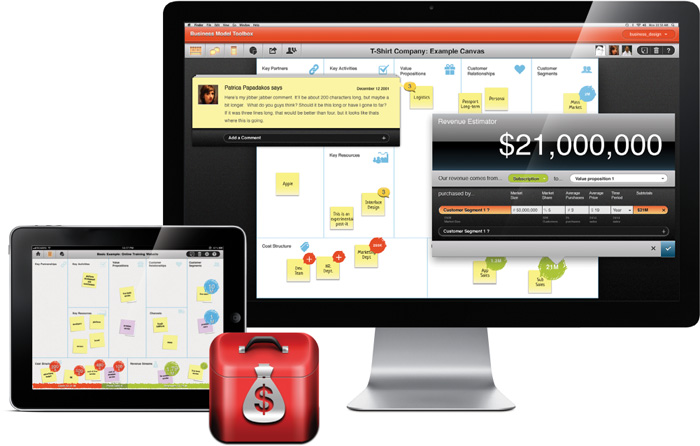
Computer-Aided Business Model Design
Improving the process
Mike, a senior business analyst with a large financial group, wraps up the first of a two-day workshop he is facilitating with a group of 24 executives. He collects the business model prototypes and ideas that participants sketched on large Canvas posters and hurries to his office.
There, Mike and his team enter the ideas into a collaborative computer-aided business model design program to further develop the prototypes. Other business analysts working overseas add resource and activity cost estimates, as well as calculations of potential Revenue Streams. The software then spits out four different financial scenarios, with business model data and prototype diagrams for each plotted on large posters. The following morning Mike presents the results to the executives, who have gathered for the second day of their workshop to discuss the potential risks and rewards of each prototype.
This scenario doesn’t yet describe reality, but that is changing rapidly. A Business Model Canvas printed on a large poster and a big box of Post-it notes will always be a very powerful tool for triggering creativity and generating innovative business model ideas. However, we extended this paper-based approach with the help of the computer, the Internet, and the iPad. Turning a prototype business model into a spreadsheet is time-consuming, and each change to the prototype usually requires a manual modification of the spreadsheet. Therefore we developed the Business Model Toolbox, Web and iPad-based platform that combines the speed of a napkin sketch with the smarts of a spreadsheet.

Scratching the Surface: a Prototype
The Business Model Toolbox makes the creation, storage, manipulation, tracking, and communication of business models far easier. The toolbox also supports collaborative work on business models for geographically disparate teams. With this software our aim is to bring the same computer support to business models than what we take for granted when we design, simulate, and build airplanes or develop software across continents. Inventing innovative business models certainly requires human creativity, but computer-aided systems can help us manipulate business models in more sophisticated and complex ways.
Try our computer Business Model Toolbox (link to iPad app) for iPad or our Web App Strategyzer.com
CAD’s Influence Past, Present and Future
An example from the field of architecture is helpful in illustrating the power of computer-aided design. In the 1980s so-called Computer-Aided Design (CAD) systems started becoming more affordable and slowly were adopted by architectural firms. CAD made it much easier and cheaper for architects to create threedimensionalmodels and prototypes. They brought speed, integration, improved collaboration, simulation, and better planning to architecture practices, Cumbersome manual tasks, such as constant redrawing and blueprint sharing, were eliminated, and a whole new world of opportunity, such as rapid visual 3-D exploration and prototyping, opened up. Today paper-based sketching and CAD happily co-exist, each method retaining its own strengths and weaknesses.
In the realm of business models, too, computer-aided systems could make many tasks easier and quicker, while revealing as-yet unseen opportunity. At the least, CAD systems could help visualize, store, manipulate, track, annotate, and communicate business models just as the Business Model Toolbox does.
More complex functions could involve manipulating layers or business model versions, or moving business model elements dynamically and evaluating the impact in real-time. Systems might facilitate business model critiquing, provide a repository of business model patterns and off-the-shelf building blocks,simulate models, or integrate with other enterprise systems (e.g. ERP or business process management).
Computer-aided business model design systems like the Business Model Toolbox will likely evolve in step with interface improvements. Manipulating business models on wall-sized touch screens would bring computer-aided design closer to the intuitive paper-based approach and improve usability.
| Paper-based | Computer-aided |
| Advantages | |
• Paper or poster-based Canvases can be easily created and used just about anywhere • Paper and poster-based Canvases impose few barriers: no need to learn a specific computer application • Very intuitive and engaging in group settings • Fosters creativity, spurs ideation when used on large surfaces |
Easy to create, store, manipulate, and track business models • Enable remote collaboration • Quick, comprehensive financial, other simulations • Provide business model design guidance (critiquing systems, business model database, pattern ideas, control mechanisms) |
| Applications | |
• Napkin sketches to draw, understand, or explain business models • Collaborative brainstorming sessions to develop business model ideas • Collaborative assessment of business models |
• Collaborative business model design with remote teams • Complex manipulations of business models (navigation, business model layers, merging models) • Deep, comprehensive analysis |